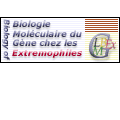
|
|















|
International Summer School
From Genome to Life:
Structural, Functional and Evolutionary approaches
SIDDIQUE Masood |
|
Johann Wolfgang Goethe-Universität, Molecular Cell Biology, Marie-Curie Strasse 9, Frankfurt Am Main 60439, Germany title: The Hsp17 Family of Arabidopsis thaliana: An Evolutionary Highly Conserved Protein Family from Prokaryotes to Human All organisms respond to sublethal temperature by expressing heat stress proteins (Hsps), which protect proteins from irreversible damage during stress periods. Hsps also act as molecular chaperones to assist in folding and intracellular topogenesis of proteins. The comparison of eukaryotic genomes revealed an unexpected multiplicity of genes in Arabidopsis thaliana encoding molecular chaperones, especially those belonging to the Hsp17 family (small Hsps, sHsps; Scharf et al., 2001), characterized by the highly conserved alpha-crystallin domain (ACD). According to their amino acid sequence and subcellular distribution plant sHsps can be subdivided into six classes: ER-localized, plastidial, mitochondrial and the two cytoplasmic representatives CI and CII (Vierling, 1991; Waters et al., 1996, 1999). Detailed analysis of the A. thaliana genome and sequence comparison identified a novel class CIII of cytosolic sHsps with the exclusive member AtHsp17.4-CIII (Scharf et al., 2001). By screening a tomato cDNA library using the Yeast Two-Hybrid System with tomato (Lycopersicon peruvianum) Hsp17.7-CI as a bait, another member (LpHsp16.1-CIII) of this class has been isolated. Structural analyses show that the ACD of sHsps consists of 8 ß-strands (ß2-ß9; Kim et al., 1998; van Mantfort et al., 2001; Scharf et al., 2001) and that the ß-strands ß2 and ß6 form the intermolecular interface for dimerization. The A. thaliana genome contains 19 sHsp and sHsp related (Scharf et al., 2001) proteins. Furthermore, we identified 25 new proteins containing the highly conserved ACD (ACD proteins). The relationship of the ACD proteins to the Hsp17 family is restricted to one or more ACDs. It is of our particular interest to investigate the function of the ACD in these so far uncharacterized proteins. The availability of the complete A. thaliana genome gives us the advantage to easily access the sHsps and ACD proteins as well as their promotors. Initial approaches to the functional analyses of these proteins and their genes have been done. 1. The promotor regions of A. thaliana sHsps contain Hsf (Heat stress transcription factor) binding sequences (heat stress elements), which are essential for the heat stress induced expression of these genes. These promotors were cloned and analysed by reporter gene assays using different Hsfs as activators. The results clearly show that distinct promotor architectures lead to different activation patterns. 2. For further investigation of class CIII sHsps, 3HA-tagged versions were expressed in tobacco mesophyll protoplasts. The proteins oligomerize to high molecular weight complexes. Unique for proteins of this class is that these complexes are localized within the nucleus. Upon heat stress the class CIII molecules are recruited to endogenous cytoplasmic HSG-complexes (heat stress granule; Nover et al., 1983, 1989; Scharf et al., 1998a; Kirschner et al., 2000). 3. The functional role of HSGs in the thermotolerance of plants is of our major interest. In order to analyse the composition of HSGs, excluding the background of unknown plant factors, plant sHsps were expressed in Chinese hamster ovary cells. Using indirect immunofluorescence, the localization behaviour of sHsps belonging to class CI, CII and CIII was investigated. |